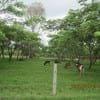Explore all the information on
Additives and feedstuffs in dairy cattle nutrition
Welcome to the page about Additives and feedstuffs in dairy cattle nutrition of Engormix; a source of knowledge on Additives and feedstuffs in dairy cattle nutrition.
Introduction Complementary grazing systems (CGS) involve the rotation of animals between forage resources of species with different patterns of seasonal growth and development (Gillen et al., 1999; Moore et al., 2004). The aim of the CGS is to overcome the seasonal deficiencies in the production of dry matter and nutrients content that are inherent to the use of a single resource. The advantages of CGS include more efficient use of each forage resource and the subsequent...
Comments : 0
Recommendations: 0
Imminent VFD regulations are anticipated to create challenging conditions for dairy producers. Yeast products are one of the many options that are being explored to overcome these challenges. There is a wide range of yeasts and yeast-derived products available but with varying efficacy. Refined Functional Carbohydrates (RFC™) derived from yeast act through a number of mechanisms to alleviate production stressors leading to improved profitability. Some of these benefits include ability...
Comments : 2
Recommendations: 5
What makes Selisseo® different? How does it work? What are its benefits for cattle? Anne-Sophie Conjat, Global Business Manager Selisseo® answers all these questions....
Comments : 0
Recommendations: 3
Silvopastoral systems One of the limitations for the efficient production of meat and milk in livestock systems of Venezuela is the scarcity of high-protein forage from plants adapted to the acid soils and prolonged droughts of the Llanos (savannas). The Llanos cover an estimated area of 15-20 M ha predominantly in the southeast and southwest of the country. They are mainly covered with native grasses (Trachypogon spp.), which have low carrying capacity (0.10-0.25 AU/ha; 1 AU =...
Comments : 1
Recommendations: 0
Introduction Feeding high-producing cows continues to challenge dairy farmers and nutritionists. Also, dairy profit margins vary as milk prices and feed costs shift yearly. Feed costs represent the largest input cost to produce milk (estimated to be 35 to 50 percent). Feed additives are a group of feed ingredients that can cause a desired animal response in a non-nutrient role, such as pH shift, growth,...
Comments : 4
Recommendations: 0
Antonio García, Technical Service Manager Ruminant at Phileo Lesaffre for Latin America, explains the news technologies Phileo has developed in feed formulations for ruminants, during CLANA 2018 in Brazil...
Comments : 18
Recommendations: 2
Key information Mepron® is a dust free mini pellet (1.8 * 3mm) with a very high degree of durability and low humidity with min. 85 % content of DL-methionine in a rumen protected form. Its specific gravity (1.2 kg/L), bulk density (650 kg/m 3 ) and angle of repose (21°) assure excellent flow and conveying properties. Using conventional mixing techniques, the product can be mixed with many types of feed ingredients quickly (2.5 min)...
Comments : 1
Recommendations: 6
Learn from Valentin Nenov, Global Species Manager Ruminants at Phileo Lesaffre Animal Care, how after the drought of 2018, Phileo can help you to get the maximum from the diet using Actisaf® in cows, during Eurotier 2018
...
Comments : 3
Recommendations: 7
Author details: 1 School of Agriculture and Food Sciences, The University of Queensland, Brisbane, QLD, Australia; 2 Instituto de Tecnología Agropecuaria (INTA), Leales, Tucumán, Argentina; 3 Centro para la Investigación en Sistemas Sostenibles de Producción Agropecuaria (CIPAV), Cali, Colombia; 4 Instituto de Ciencia Animal (ICA), La Habana, Cuba; 5 Formerly: Universidad de Los Andes, Facultad de Ciencias Forestales y Ambientales,...
Comments : 0
Recommendations: 0
Background Carinata (Brassica carinata) is a new oilseed that shows great potential for the Midwest. This oilseed has been selectively bred for high oil concentration ideal for biofuels and bio-oil production. Carinata meal is the co-product resulting from the oil extraction of the seeds. This meal has high protein content (36-48% crude protein), highly degradable in the rumen, and with a total digestibility of the protein a...
Comments : 1
Recommendations: 0
Fat found in milk originates from three sources; de novo fatty acids synthesised in the milk gland of the cow (short-chain C4 to C14) comprise about 20-30% of total milk fatty acids, preformed fatty acids (long chain C18:0, C18:1 and C18:3) represent 35-40%, and the mixed group of fatty acids (C16) make up about 35%.
Research has shown that the percentage of milk de novo fatty acids is positively correlated with the percentage of fat and true protein in the milk. It has also been...
Comments : 26
Recommendations: 6
Selsaf®3000 is a natural source of organic selenium for all species of animals (pigs, poultry, dairy, aquaculture…) The main compounds of Selsaf®3000 are L-selenomethionine and L-selenocysteine. L-selenomethionine is incorporated into body proteins as the main selenium storage, and used as a precursor to L-selenocysteine. L-selenocysteine plays an essential role against oxidative stress as a key element ensuring the activity of the antioxidant enzyme glutathione peroxidase....
Comments : 7
Recommendations: 6
Kuo-Wei Ssu, Sales Manager for ICC in China, gave Engormix.com an interview in Chinese Mandarim about Hilyses, the company's bionic prebiotic....
Comments : 0
Recommendations: 5
(Video in French) Maxime Briche, Ruminant Technical Support at Phileo Lesaffre Animal Care, points out the befits of using Actisaf® Sc 47 HR+ new generation: from heat resistance to multifactorial resistance, in Eurotier 2018....
Comments : 0
Recommendations: 3
RP Amino Acids...
Comments : 0
Recommendations: 0
Use a blend of plant extracts as dietary antioxidant in animal production The objective of this article is to provide an introduction on oxidative stress, some concepts and suggestions to improve the efficiency of dietary antioxidants, including Silvafeed® ATX blend of plant extracts. This article is based on many concepts recently published in some important reviews (e.g. Bradford et al., 2015; Salami et al., 2015; Salami et al., 2016, and...
Comments : 1
Recommendations: 2
Introduction
Tannins are commonly defined as water-soluble polyphenolic compounds ranging in a molecular weight from 500 to 3000 Daltons. Muller-Harvey (2006) reviewed the effects of different types of tannins on animal nutrition and health. Results indicates that tannins form a highly diverse group of natural products with promising nutritional, veterinary, and environmental effects. Studies feeding a...
Comments : 2
Recommendations: 2
Rumen-protected lysine (Lys) and methionine (Met) are becoming common fixtures in dairy rations, particularly in those where milk is sold not only for volume, but also for the component values.
Research and practice have shown repeatedly that improving the Lys and Met profiles in the diet (where increased dietary levels of these limiting amino acids are available to the small intestine) results in increased milk volume,...
Comments : 3
Recommendations: 2
The company's R&D Coordinator explains the benefits of the yeast cell wall used to control pathogens contamination....
Comments : 0
Recommendations: 1







.jpg&w=3840&q=75)


















